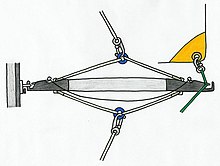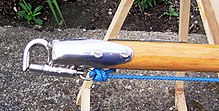Spinnaker pole

A spinnaker tree or spinnaker tree for short (sometimes also referred to as a whisker tree ) is a spar made of aluminum , wood or carbon fiber reinforced plastic (CFRP) that is used to expand the spinnaker to windward (to keep it open against the wind). For this purpose, one side of the spinnaker boom is attached to the mast , the other is latched into the stern hauler (also: windward sheet) and the windward clew of the spinnaker is pulled to the boom.
To the sail to trim , the spinnaker pole by using a top transformants up or a vang downwardly tilted and pulled with the afterguys aft. In addition, on many boats there is the option of adjusting the attachment point for the spinnaker pole on the mast with the help of a slide.
There are two types of spinnaker trees
- Symmetrical: Both ends of the tree are provided with the same end fittings and these are usually directly connected by a release cord with which both end fittings can be opened. Such spinnaker poles are primarily used on small boats and cruising yachts. A horizontal ring or half-ring serves as a fastening point on the mast. One advantage of this construction is that with a jibe with a spinnaker, the spinnaker pole can simply be pushed through to the other side . (It does not have to be turned on the forecastle .) This procedure is known as an end-to-end maneuver .
- Asymmetrical: One side has an end fitting for latching the windward sheet, the other is conical and is inserted into a bell fitting (a movable cup) on the mast. Asymmetrical spinnaker poles are found on large yachts, especially on regatta boats, when end-to-end maneuvers are difficult or unsafe anyway due to the forces involved.
literature
- Bent Aarre, Matthias Beilken: Spinnaker sailing . 10th edition, Delius Klasing, Bielefeld 2003


